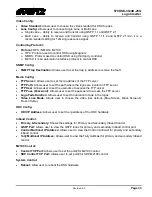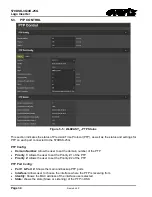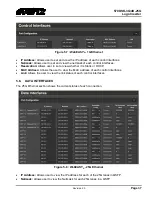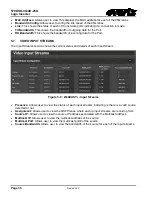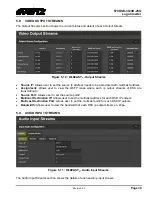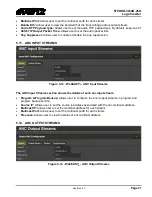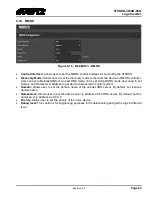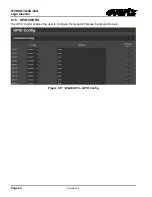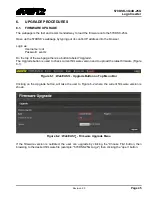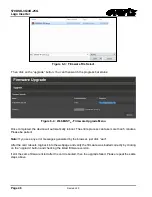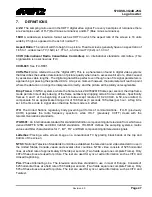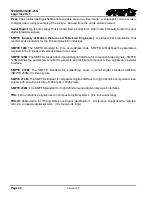
570DSK-3G
/
4K-25G
Logo Inserter
Revision 2.0
Page 47
7.
DEFINITIONS
4:2:2:
The sampling ratio used in the HDTV digital video signal. For every 4 samples of luminance there
are 2 samples each of R-Y (Red minus Luminance) and B-Y (Blue minus Luminance).
16X9:
A widescreen television format such as HDTV in which the aspect ratio of the screen is 16 units
wide by 9 high as opposed to the 4x3 of normal TV.
Aspect Ratio:
The ratio of width to height in a picture. Theatre screens generally have an aspect ratio of
1.85 to 1, widescreen TV (16x9) is 1.77 to 1, and normal TV (4x3) is 1.33 to 1.
CCIR (International Radio Consultative Committee):
An international standards committee. (This
organization is now known as ITU)
CCIR-601:
See ITU-R601.
Cliff effect:
(Also referred to as the “digital cliff”) This is a phenomenon found in digital video systems
that describes the sudden deterioration of picture quality when due to excessive bit errors, often caused
by excessive cable lengths. The digital signal will be perfect even though one of its signal parameters is
approaching or passing the specified limits. At a given moment however, the parameter will reach a point
where the data can no longer be interpreted correctly, and the picture will be totally unrecognizable.
Drop Frame:
In NTSC systems, where the frame rate is 29.97002618 frames per second, the drop frame
mode permits time of day indexing of the frame numbers by dropping certain frame numbers. Specifically
frames 0, and 1 at the beginning of each minute except minutes 0,10,20,30,40, & 50, are omitted, to
compensate for an approximate timing error of 108 frames (3 seconds 18 frames) per hour. A flag bit is
set in the time code to signal when the drop frame mode is in effect.
ITU:
The United Nations regulatory body governing all forms of communications. ITU-R (previously
CCIR) regulates the radio frequency spectrum, while ITU-T (previously CCITT) deals with the
telecommunications standards.
ITU-R601:
An international standard for standard definition component digital television from which was
derived SMPTE 125M and EBU 3246-E standards. ITU-R601 defines the sampling systems, matrix
values and filter characteristics for Y, B-Y, R-Y and RGB component digital television signals.
Letterbox:
Placing a wide screen image on a conventional TV by placing black bands at the top and
bottom of the screen.
NTSC:
National Television Standards Committee established the television and video standard in use in
the United States, Canada, Japan and several other countries. NTSC video consists of 525 horizontal
lines at a field rate of approximately 60 fields per second. (Two fields equal one complete Frame). Only
487 of these lines are used for picture. The rest are used for sync or extra information such as VITC and
Closed Captioning.
PAL:
Phase Alternating Line. The television and video standard in use in most of Europe. Consists of
625 horizontal lines at a field rate of 50 fields per second. (Two fields equal one complete Frame). Only
576 of these lines are used for picture. The rest are used for sync or extra information such as VITC and
Teletext.
Summary of Contents for 570DSK-25G Series
Page 2: ...This page left intentionally blank ...
Page 6: ...570DSK 3G 4K 25G Logo Inserter Page ii Revision 2 0 This page left intentionally blank ...
Page 10: ...570DSK 3G 4K 25G Logo Inserter Page 2 Revision 2 0 Figure 1 1 570DSK 3G 4K 25G Block Diagram ...
Page 12: ...570DSK 3G 4K 25G Logo Inserter Page 4 Revision 2 0 Page left intentionally blank ...
Page 20: ...570DSK 3G 4K 25G Logo Inserter Page 12 Revision 2 0 Page left intentionally blank ...
Page 38: ...570DSK 3G 4K 25G Logo Inserter Page 30 Revision 2 0 Figure 5 2 WebEASY 570DSK 25G Main Menu ...

